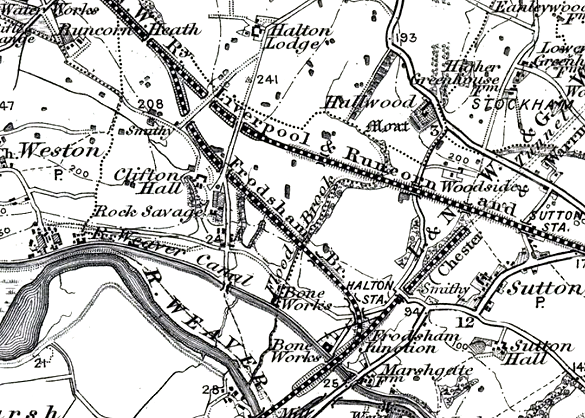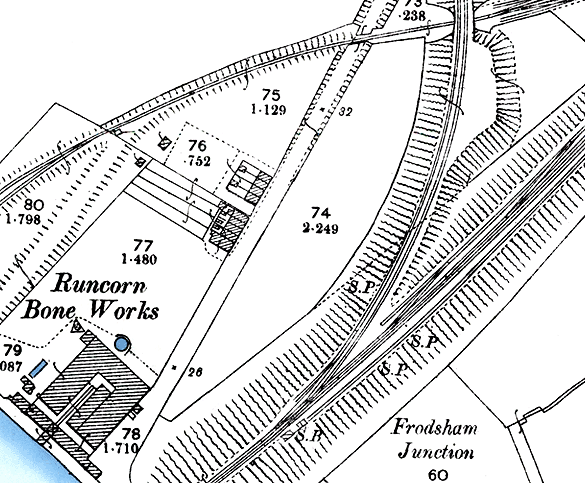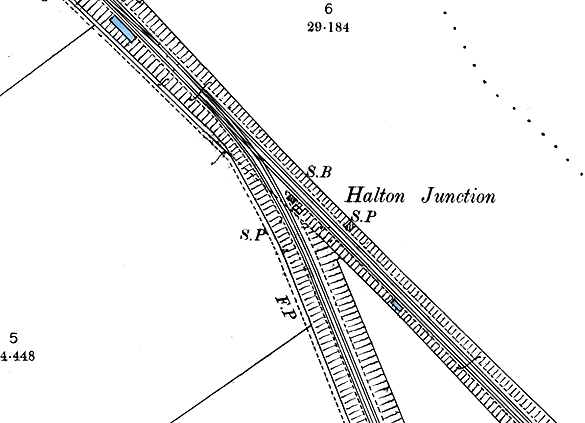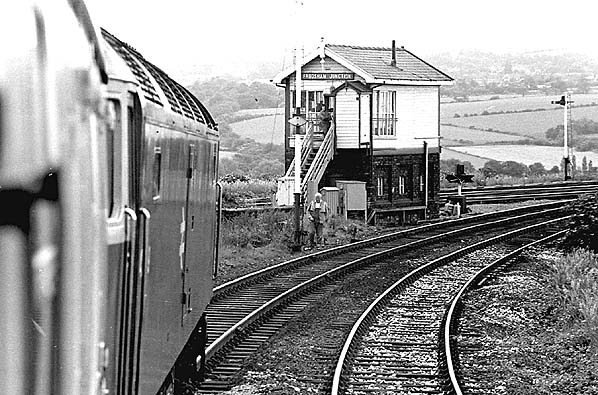|
The Halton Curve was originally opened as a double-track railway by the London & North Western Railway on 1 May 1873. At the time of opening it was simply known as the Frodsham Branch line. At 1 mile and 54 chains the line provided a link between the LNWR’s Ditton Junction to Weaver Junction line which had opened on 1 April 1869 and the Birkenhead Joint Railway’s (BJR) Chester and Warrington line which had opened on 31 October 1850. The BJR was a joint concern of the Great Western Railway (GWR) and the LNWR.
The Ditton Junction – Weaver Junction line was built to provide a short cut over the River Mersey for trains travelling between Liverpool and London; they were previously routed via Warrington. The connection to the BJR branched off from the main line at Halton Junction (Runcorn) and ran for a mile and a half to form a junction with the BJR at Frodsham Junction (Sutton Weaver). The Halton curve allowed LNWR trains to run direct between Liverpool and North Wales.
 The Halton Curve shown as the 'Frodsham Branch' of the LNWR on a one-inch scale map from 1896.
The Halton Curve shown as the 'Frodsham Branch' of the LNWR on a one-inch scale map from 1896.
|
The controlling signal box at Frodsham Junction opened on 25 November 1872. It was an LNWR & GWR Type 1 provided with a 20-lever frame. The box stood on the up side (Chester direction) of the BJR main line.
The controlling signal box at Halton Junction opened in 1872. It was probably a Saxby & Farmer Type 6 box which were common on the LNWR line at that time.
The line originally had four underbridges, five overbridges and a culvert. Towards its southern end it was built up on an embankment and its northern end was in a cutting. A short distance north of Frodsham Junction the Sutton Dock Branch line passed under the Halton Curve.
 The LNWR ran passenger and goods trains over the Halton Curve. Passenger services consisted of local and long-distance express services, the latter running between Liverpool and destinations in North Wales. The LNWR ran passenger and goods trains over the Halton Curve. Passenger services consisted of local and long-distance express services, the latter running between Liverpool and destinations in North Wales.
In June 1893 the original Frodsham Junction signal box was closed and replaced with an LNWR Type 4 structure with a brick base and timber upper cabin. The new box was equipped with an LNWR 32-lever Tumbler frame. It was also located on the up side of the main line.
In July 1897 a new box was provided at Halton Junction. It was located in close to the junction between the curve and the main line. The box was an LNWR Type 4. It had a brick base and wooden upper cabin of the LNWR size E. The box was equiped with a 25 Lever LNWR Tumbler frame.
In June 1913 Frodsham Junction signal box was replaced yet again, this time with an LNWR Type 5 structure. The new box was on the down side of the line in the fork of the junction. The frame from the 1893 box was transferred to the new one.
On 1 January 1923 the line became part of the LMS (into which the LNWR was absorbed). This company continued to operate a regular passenger service over the line.
 Frodsham Junction shown on a twenty five-inch scale map from 1897.
Frodsham Junction shown on a twenty five-inch scale map from 1897. |
On 1 January 1948 the Halton Curve became part of British Railways (London Midland Region). Throughout the 1950s there were frequent passenger services over the line and it was well used by goods services.
In 1969 a bridge was added to carry the line over the M56 motorway and in the early 1970s a short tunnel and an overbridge was added towards the north end of the line to carry an expressway road and a busway over the line.
In 1964 BR (LMR) reduced service levels and sought to withdraw the service altogether. Consent was refused in 1966 but from the 6 March 1967 a revised service was introduced that deliberately destroyed connections and left only a very sparse service in the middle of day. Although supported by a grant in 1969 by May 1973 there were only six passenger trains per day in each direction over the Halton Curve on weekdays running between Runcorn and Chester except for one which ran from Liverpool. A few extra services ran on Saturdays. The service was withdrawn completely with effect from 5 May 1975.
Summer-only services between Liverpool Lime Street and North Wales continued to run. They continued into the 1980s but with reduced frequency.
The line was also used by diverted main line trains during the period from 1964 until the 1980s. If the main line between Runcorn and Crewe was closed for engineering works, services were diverted via the Halton Curve and Chester.
 Halton Junction shown on a twenty five-inch scale map from 1897.
Halton Junction shown on a twenty five-inch scale map from 1897. |
In 1994 the former up line (Frodsham Junction direction) was lifted leaving only the down (Halton Junction direction). The down line was not made bi-directional with the result that trains could run only from Frodsham Junction to Halton Junction. Railtrack, which had become the owner of the line sought to close it but without success. Because of this the summer Saturday service had to be continued but reduced to one train on Saturday.
After 1994 the line was little used. There were occasional freight trains and light engine movements as well as the summer Saturday service.
In 2003 a further closure proposal, this time by Network Rail (which had taken over from Railtrack) was vigorously fought off. A campaign by the North Cheshire Rail Users’ Group (NCRUG) sought to reinstate the Halton Curve as a bi-directional railway.
In March 2006 Frodsham Junction signal box was refurbished. Halton Junction was refurbished in June of the same year.
The persistence of NCRUG supported by local authorities paid off and in October 2014 a £10.4 million scheme to restore the line to a bi-directional route was announced. On 15 April 2016 the Liverpool City Region Combined Authority (LCRCA) approved the ‘Full Business Case’ for the ’Halton Curve Major Scheme’. The plan is to have an hourly service running in each direction between Liverpool Lime Street and Chester by May 2018.
|


 Home Page
Home Page 

 Home Page
Home Page